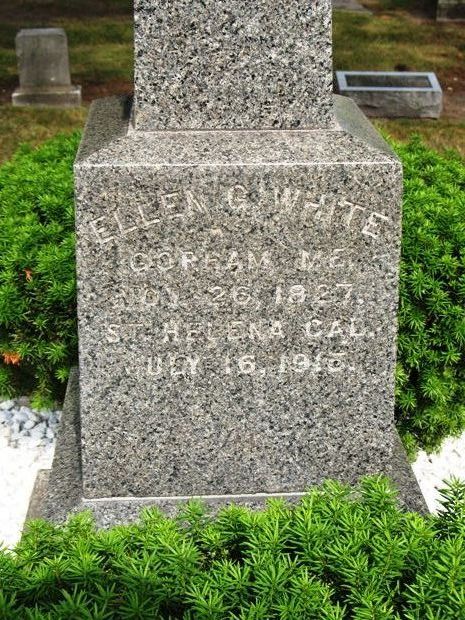|
|
General: ELLEN WHITE JULY 16TH 1915 APOLLO 11 ISLAMIC CALENDARAR HOLY GRAIL FREEMASONRY
Scegli un’altra bacheca |
|
Rispondi |
Messaggio 1 di 14 di questo argomento |
|
|
|
|
 Primo
Primo
 Precedente
2 a 14 di 14
Successivo
Precedente
2 a 14 di 14
Successivo
 Ultimo
Ultimo

|
|
Rispondi |
Messaggio 2 di 14 di questo argomento |
|
|
|
|
Rispondi |
Messaggio 3 di 14 di questo argomento |
|
Shrine of the Three Kings
From Wikipedia, the free encyclopedia
The Shrine of the Three Kings[1] (German Dreikönigsschrein[2] or Der Dreikönigenschrein),[3] Tomb of the Three Kings,[4] or Tomb of the Three Magi[5] is a reliquary traditionally believed to contain the bones of the Biblical Magi, also known as the Three Kings or the Three Wise Men. The shrine is a large gilded and decorated triple sarcophagus placed above and behind the high altar of Cologne Cathedral in western Germany. Built approximately from 1180 to 1225, it is considered the high point of Mosan art and the largest reliquary in the Western world.
History[edit]

Chapel of the Magi, Cologne Cathedral, where the Shrine of the Three Kings was kept from 1322 until 1948.
The "relics of the Magi" were originally situated at Constantinople, but brought to Milan in an oxcart by Eustorgius I, the city's bishop, to whom they were entrusted by the Emperor Constantine in 314.[6] Eight centuries later in 1164, Holy Roman Emperor Frederick Barbarossa took the relics of the Magi from the church of Saint Eustorgio in Milan and gave them to the Archbishop of Cologne, Rainald of Dassel.[7] The relics have since attracted a constant stream of pilgrims to Cologne.
"In the days of Philipp of Heinsberg the shrine of the three magi was built. This was told to me by some eyewitnesses who were present when the three magi were put into the shrine." — Vita Eustorgii[8]
Parts of the shrine were designed by the famous medieval goldsmith Nicholas of Verdun,[9] who began work on it in 1180 or 1181. It has elaborate gold sculptures of the prophets and apostles, and scenes from the life of Christ. The shrine was completed circa 1225.
Around 1199, King Otto IV gave three golden crowns, purported to be made for the three wise men, as a present to the church of Cologne. Because of the importance of the shrine and the cathedral for the later development of the city, the coat of arms of Cologne still shows these three crowns symbolizing the Three Kings.
Construction of the present Cologne Cathedral begun in 1248 to house these important relics. The cathedral took 632 years to complete and is now the largest Gothic church in northern Europe.
On 20 July 1864, the shrine was opened, revealing human remains and the coins of Philip I, Archbishop of Cologne. An eyewitness report reads:
- "In a special compartment of the shrine now there showed – along with remains of ancient old rotten or moulded bandages, most likely byssus, besides pieces of aromatic resins and similar substances – numerous bones of three persons, which under the guidance of several present experts could be assembled into nearly complete bodies: the one in his early youth, the second in his early manhood, the third was rather aged. Two coins, bracteates made of silver and only one side stricken, were adjoined; one, probably from the days of Philipps von Heinsberg, displayed a church (See Note), the other showed a cross, accompanied by the sword of jurisdiction, and the crosier (bishop's crook) on either side."[10]
- Note: "Just as the coin of Philipp in Hartzheim, historia rei nummariae coloniensis Table 3 No. 14, 16, (1754),[11] yet without its circumscription; the other (coin) is in square form, showed in the center a cross, accompanied by the sword of jurisdiction, and the crosier (bishop's crook) on either side, also without transcription, most certainly it is not younger and can be assumed perhaps to turn out to be a coin by Rainald [of Dassel]."[12]
The bones were wrapped in white silk and returned to the shrine.
Description[edit]
Size and construction[edit]
The Shrine of the Three Kings is approximately 110 cm (43 in) wide, 153 cm (60 in) high, and 220 cm (87 in) long. It is shaped like a basilica: two sarcophagi stand next to each other, with the third sarcophagus resting on their roof ridges. The ends are completely covered, so there is no space visible between the sarcophagi. The basic structure is made of wood, with gold and silver overlay decorated with filigree, enamel, and over 1,000 jewels and beads. The latter include a large number of cameos and intaglio pieces, some pre-Christian.
Decoration[edit]
The entire outside of the shrine is covered with an elaborate decorative overlay. There are 74 high relief figures in silver-gilt in all, not counting smaller additional figures in the background decoration. On the sides, images of the prophets decorate the lower part, while images of the apostles and evangelists decorate the upper part. On the front end of the reliquary, there are (across the bottom, from left to right) images of the Adoration of the Magi, the Virgin Mary enthroned with the infant Jesus, and the Baptism of Christ, and above, Christ enthroned at the Last Judgment. A removable filgree panel reveals a grille displaying the names of Caspar, Melchior, and Balthasar. When the grille is removed, the skulls of the three Magi are shown wearing crowns. The other end of the reliquary shows scenes of the Passion: the scourging of Christ (lower left) and his crucifixion (lower left) with the resurrected Christ above. This end also has a bust of Rainald of Dassel in the center.
|
|
|
|
Rispondi |
Messaggio 4 di 14 di questo argomento |
|
|
|
|
Rispondi |
Messaggio 5 di 14 di questo argomento |
|

Did You Know About the Relics of the Three Wise Men?
When I was in college, I journeyed to Cologne, Germany and visited the city’s glorious cathedral. I was a Protestant at the time, but I remember being amazed that people had been building this cathedral for so many centuries. It is one of the greatest Gothic churches of all time.
 St Peter and St Mary Cathedral in Cologne, Germany St Peter and St Mary Cathedral in Cologne, Germany
A tour guide informed me that the bodies of the three Wise Men were enshrined inside. I wasn’t much impressed by the remains of dead people, but this was something that perked my interest – the earthly remains of “we three kings of orient are.” It was perhaps my first investigation into one of those things that Protestants find icky: relics.
According to legend, the bodies of Gaspar, Balthasar, and Melchior (the traditional names of the Wise Men) were discovered by Saint Helena during her pilgrimage to the Holy Land. The fourteenth century account by John of Hildesheim entitled History of the Three Kings explains how Queen Saint Helen brought the mummies of the Magi to Constantinople.
After she had found the bodies of Melchior, Balthazar, and Gaspar, Queen Helen put them into one chest and ornamented it with great riches, and she brought them into Constantinople.
Later, the three mummies were transferred from Constantinople to Milan. The city of Milan was once known for its festive observance of the feast of Epiphany, and the presence of the three Wise Men’s relics in that city may be the context and origin for this ancient custom. The Holy Roman Emperor Frederick moved the mummified Magi one last time to Cologne in AD 1164 where they rest till this day. If you get to Germany, be sure to check it out.
 Photo of the golden casket of the three Wise Men
Are the bones of three Wise Men really in Germany? God only knows…but I like to think so. And remember: Wise Men still seek Jesus.
You may also like:
https://taylormarshall.com/2010/01/did-you-know-about-relics-of-three-wise.html
|
|
|
|
Rispondi |
Messaggio 6 di 14 di questo argomento |
|
|
|
|
Rispondi |
Messaggio 7 di 14 di questo argomento |
|
|
|
|
Rispondi |
Messaggio 8 di 14 di questo argomento |
|
|
|
|
Rispondi |
Messaggio 9 di 14 di questo argomento |
|
ANCIENT EGYPTIAN GEODESY - PART II
The great circle alignment from Giza to Alexandria has an azimuth of 51.85° north of due west from Giza (the same angle as the slope of the Great Pyramid). Extended beyond Alexandria, this great circle also crosses over Delphi, Rollright and Newgrange, as well as the city of London.
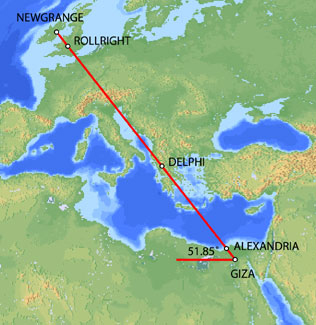
Map image © VectorGlobe
The azimuth of a great circle alignment from Dendera to Paris is also 51.85° north of due west.

Map image - Roger Hedin
Dendera was dedicated to Isis/Sirius. The ancient Egyptian year began on the date of the heliacal rising of Sirius in mid July. The helical rising of Sirius heralded the annual inundation of the Nile that was essential to the welfare of ancient Egypt. The axis of the temple of Isis at Dendera was aligned 20° south of due east, pointing directly at the rising point of Sirius from the latitude of Dendera.
Robert Bauval describes a number of connections between Isis/Sirius and Paris in Talisman (2004). Isis is shown riding on a boat in many ancient Egyptian drawings and carvings. At the direction of Napoleon, Sirius and a statue of Isis were added to the coat of arms for Paris shown below.
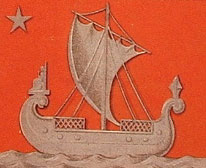
During the French revolution, a statue of Isis known as the Fountain of Regeneration was constructed on the former site of the Bastille. The engraving below commemorated this statue.
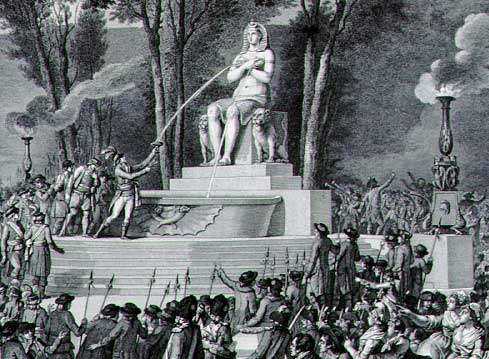
Fountain of Regeneration Engraving
The Elysian Fields is described as a place of eternal salvation in the ancient Egyptian Book of the Dead. Named after the Elysian Fields, the Champs Elysees is the main axis of Paris. The names Elysian and Elysees both suggest an association with Isis. The photograph below is facing southeast. The Arc de Triumphe is visible in the background. Beyond the Arc de Triumphe is the Louvre. The azimuth of the Champs Elysees is 26° south of due east, pointing directly at the rising point of Sirius/Isis from the latitude of Paris.
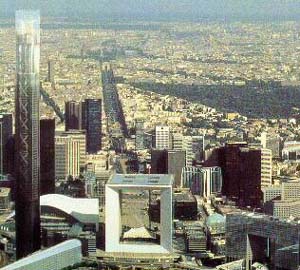
The termination point of the Champs Elysees to the northwest is the Grande Arche, in the foreground of the picture above. The axis of the Grande Arche is offset 6.33° south of the axis of the Champs Elysees. With an azimuth of just over 32° south of due east, the azimuth of the axis of the Grande Arche is the same as the azimuth of the great circle alignment from Paris to Dendera.
The Grande Arche is a nearly perfect cube with a height of 110 meters, a width of 108 meters and a depth of 112 meters. It is often described as a cube with side lengths of 110 meters. This is equal to 210 ancient Egyptian cubits:
110/210 = .5238
.5238 meters is a precise measure of the ancient Egyptian cubit, equating to 20.6222 inches, well within the ± .005 inches in Petrie's 20.62 inch measure of the ancient Egyptian cubit. Instead of the usual comparisons between the cubit and the meter of .52375/1 or .524/1, the best comparative measure may be the simple fraction of 11/21 that is suggested by the Grande Arche.

Image © Insecula.com
The sides of the Grande Arche are divided into 5 x 5 large panels and within each large panel are 7 x 7 smaller panels. Side lengths of 110 meters suggest lengths of 22 meters for the sides of the large panels with lengths of 22/7 meters for the sides of the smaller panels. The fraction 22/7 equals 3.1428, an accurate expression of π that is also found in the dimensions of the Great Pyramid. Side lengths of 210 cubits in the Grande Arche suggest lengths of 42 cubits for the sides of the large panels and 6 cubits for the sides of the smaller panels. This also shows that the relationship between the meter and the cubit is 6/π, using the measure of 22/7 for π:
21/11 = 6/π
22/7 x 21/11 = 6
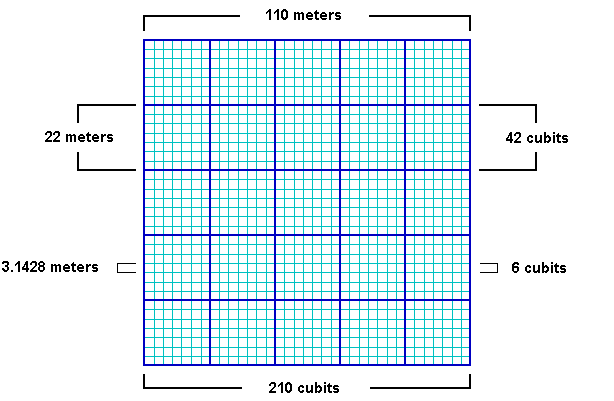
The northern pyramid at Dashur, known as the Red Pyramid, was the first true (smooth sided) pyramid built in Egypt and it was the last pyramid built prior to construction of the Great Pyramid. The baselengths of the Red Pyramid are 420 cubits (220 meters) long, 20x multiples of 21/11.

Image by Jon Bodsworth
One of the oldest stone circles in England is at Rollright. The diameter of the Rollright circle is 31.4 meters, an accurate expression of π times 10 meters. Given the 6/π relationship between the meter and the cubit, the diameter of the Rollright circle is also 60 ancient Egyptian cubits.
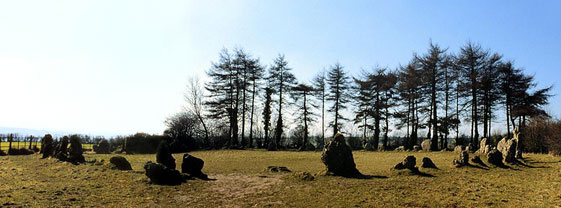
BACK
http://home.hiwaay.net/~jalison/Art5.html |
|
|
|
Rispondi |
Messaggio 10 di 14 di questo argomento |
|
Episode 134
n 1854 a slab of marble donated by Pope Pius IX arrived in Washington, D.C. He had it engraved “A Roma Americae,” or “From Rome to America,” as a sign of goodwill. He had sent it over to be included in the Washington Monument, which was then under construction. Many foreign governments had sent similar contributions to honor America’s first president. The Know Nothings, however, had no intention of allowing a gift from the Pope to be included in the Washington Monument. They were certain the stone was a sign of darker intentions by the Pope. So on March 9, 1854, under cover of darkness, a group of these anti-Catholics broke into the yard, stole the stone, and after damaging it with hammers they dropped it in the Potomac River. No one was ever credibly accused of the crime, despite reward offers and a public outcry. Many years later, however, after a tip, the stone was discovered… only to disappear again. But today, there is a stone from the Pope in the Washington Monument, this one was provided by Pope John Paul II in 1982.
Episodes Referenced
Books
https://americancatholichistory.org/the-popes-stone-and-the-washington-monument/ |
|
|
|
Rispondi |
Messaggio 11 di 14 di questo argomento |
|
|
|
|
Rispondi |
Messaggio 12 di 14 di questo argomento |
|
|
|
|
Rispondi |
Messaggio 13 di 14 di questo argomento |
|
|
|
|
Rispondi |
Messaggio 14 di 14 di questo argomento |
|
|
|
 Primo
Primo
 Precedente
2 a 14 de 14
Successivo
Precedente
2 a 14 de 14
Successivo
 Ultimo
Ultimo

|
|
| |
|
|
©2025 - Gabitos - Tutti i diritti riservati | |
|
|

